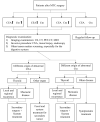Management of medullary thyroid cancer based on variation of carcinoembryonic antigen and calcitonin
- PMID: 39449744
- PMCID: PMC11499115
- DOI: 10.3389/fendo.2024.1418657
Management of medullary thyroid cancer based on variation of carcinoembryonic antigen and calcitonin
Abstract
Carcinoembryonic antigen (CEA) and calcitonin (Ctn) are pivotal biomarkers in the diagnosis and management of medullary thyroid carcinoma (MTC). However, their diagnostic reliability in perioperative period remains a topic of ongoing debate. This review synthesizes researches on perioperative fluctuations in CEA and Ctn levels, and evaluates the impact of their different combinations on MTC diagnosis, treatment decisions, and prognosis. Our findings highlight it is crucial to understand and interpret the various combinations of CEA and Ctn fluctuations within a clinical context. Furthermore, to reduce diagnostic errors and improve patient outcomes, we recommend follow-up diagnostic and treatment protocols designed to address the potential pitfalls associated with the use of these biomarkers.
Keywords: calcitonin (Ctn); carcinoembryonic antigen (CEA); follow-up; medullary thyroid carcinoma (MTC); perioperative management.
Copyright © 2024 Wang, Huang and Chen.
Conflict of interest statement
The authors declare that the research was conducted in the absence of any commercial or financial relationships that could be construed as a potential conflict of interest.
Figures
Similar articles
-
Medullary thyroid carcinoma with double negative calcitonin and CEA: a case report and update of literature review.BMC Endocr Disord. 2019 Oct 16;19(1):103. doi: 10.1186/s12902-019-0435-7. BMC Endocr Disord. 2019. PMID: 31619220 Free PMC article. Review.
-
Combining serum calcitonin, carcinoembryonic antigen, and neuron-specific enolase to predict lateral lymph node metastasis in medullary thyroid carcinoma.J Clin Lab Anal. 2020 Jul;34(7):e23278. doi: 10.1002/jcla.23278. Epub 2020 Mar 6. J Clin Lab Anal. 2020. PMID: 32141647 Free PMC article.
-
Calcitonin and complementary biomarkers in the diagnosis of hereditary medullary thyroid carcinoma in children and adolescents.J Pediatr Endocrinol Metab. 2021 Sep 21;34(12):1491-1504. doi: 10.1515/jpem-2021-0163. Print 2021 Dec 20. J Pediatr Endocrinol Metab. 2021. PMID: 34543539 Review.
-
Disparity between tissue and serum calcitonin and carcinoembryonic antigen in a patient with medullary thyroid carcinoma.Endocrine. 2011 Apr;39(2):148-52. doi: 10.1007/s12020-010-9433-2. Epub 2011 Jan 18. Endocrine. 2011. PMID: 21243446
-
Diagnostic Accuracy of 18F-FDG PET/CT in Patients With Biochemical Evidence of Recurrent, Residual, or Metastatic Medullary Thyroid Carcinoma.Clin Nucl Med. 2019 Mar;44(3):194-200. doi: 10.1097/RLU.0000000000002414. Clin Nucl Med. 2019. PMID: 30562193
Cited by
-
Thyroid Cancer: Epidemiology, Classification, Risk Factors, Diagnostic and Prognostic Markers, and Current Treatment Strategies.Int J Mol Sci. 2025 May 28;26(11):5173. doi: 10.3390/ijms26115173. Int J Mol Sci. 2025. PMID: 40507982 Free PMC article. Review.
-
Circulating Biomarkers of Thyroid Cancer: An Appraisal.J Clin Med. 2025 Feb 26;14(5):1582. doi: 10.3390/jcm14051582. J Clin Med. 2025. PMID: 40095491 Free PMC article. Review.
-
Neuroendocrine Neoplasms of the Lungs, Thyroid, and Thymus.Biomedicines. 2025 Apr 24;13(5):1028. doi: 10.3390/biomedicines13051028. Biomedicines. 2025. PMID: 40426858 Free PMC article. Review.
References
Publication types
MeSH terms
Substances
Supplementary concepts
LinkOut - more resources
Full Text Sources
Medical


